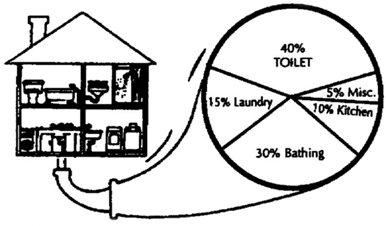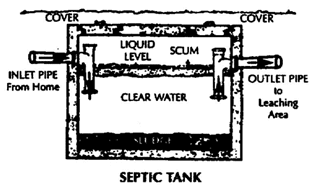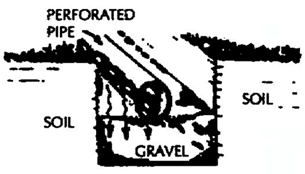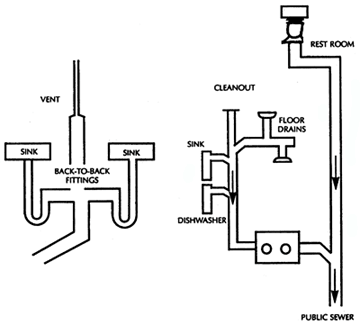Sewer and Drain Problems
Common causes of sewer and drain problems include:
Build-up of:
- Grease
- Soap Residue
- Sludge
Various foreign objects:
- Hair & Lint
- Feminine Products
- Paper Towels
Roots
Poor installation or ground settling causing low spots, inadequate slope or breaks in the line.
Grease in a Line
Most grease stoppages are due to a gradual buildup of small amounts of grease over the years. A one-time overload stoppage is possible, but is rare.
CAUTION: Stoppages due to grease build-up are more complex than they appear. The blockage may be at one or several points and there may be other points where the grease may soon cause a blockage. A quick pass with a sewer cable may only make a small hole in the grease and the line may clog again soon.
Roots
Roots enter lines through microscopic holes at joints and fittings or at fractures. Within the line they tend to grow first on the top and sides of a line. The blade used to cut roots must be a size close to the diameter of the line in order to reach to the top and sides.
Broken or Collapsed Lines
Damage can be caused by nearby construction, or as a result of excessive root growth, improper connections, or other installation defects. When this condition is verified it is normally advisable to replace the damaged portion of the line.
Settling and Slope Problems
Low spots, poor connections, or inadequate slope to a line are usually caused by improper installation. Typically, the conditions caused by their defects do not cause problems for many years.
If you are like most people, you know very little about your septic tank system. This is understandable. In urban and suburban areas there are sewers to carry household waste to municipal wastewater treatment plants. In more rural areas, however, septic tank systems provide the functions of both sewers and treatment plants.
All household waste is disposed of through the septic system. The proper operation of the septic system is essential to health, property value, and the environment. To see if you know enough about your septic system, answer the following questions. If you cannot answer all the questions, your septic system could become a huge aggravation, public nuisance, health hazard and financial burden.
- Do you know what a septic tank is and how it works?
- Do you know what kind of soil absorption area you have and how it works?
- Do you know what causes septic system to fail?
- Do you know what it costs to replace a faulty septic system?
- Do you know that a faulty septic system creates health hazards and pollutes the ground water?
These are very serious questions. The health of your family and the value of your property rely heavily upon the answers to these questions.
“An ounce of prevention is worth a pound of cure” was never truer than it is with septic tank care. A small commitment to the care of your septic system will protect you indefinitely from the nightmare created by a failing system. This website will try to give you a fairly clear picture of how household waste is treated from drain to soil.
The quantity and composition of waste generated in the home varies according to the number of residents, their personal water usage, and the water-using appliances in the home.

The septic system is a small, on-site sewage treatment and disposal system buried in the ground. The septic system is comprised of a septic tank and a soil absorption area.
The septic was patented in London around 1900. Webster’s Dictionary defines the septic tank as “a tank in which waste material is decomposed through bacterial action.” The modern septic tank is a watertight box usually made of precast concrete, concrete blocks, or reinforced fiberglass. When household waste material enters this box, several things occur:
- Organic solid material floats to the surface and forms a layer of what is commonly called “scum.” Bacteria in the septic tank biologically converts this material to liquid.
- Inorganic, or inert solid materials, and the by-products of bacterial digestion sink to the bottom of the tank and form a layer commonly called “sludge.”
- Only fairly clear water should exist between the scum and sludge layers. It is this clear water, and only this clear water, that should overflow into the soil absorption area.

Solid material overflowing into the soil absorption area should be avoided at all costs. This solid overflow that clogs soil pores and causes septic systems to fail. Two main factors cause solid material to build up enough to overflow: Bacterial deficiency and lack of sludge removal.
SOIL ABSORPTION – OR LEACH AREA:
There are many kinds of soil absorption or leaching systems. There are too many to discuss them all. There are three main ways to carry off the overflow water from the septic tank: leaching fields, filter beds, and drainage pits (also called dry wells or cesspools.)
Leaching fields generally consist of a network of perforated pipes laid in a gravel lined trench. Solids clogging the pipe perforations will cause drainage to slow and even eventually stop.

DO NOT NEGLECT YOUR SEPTIC SYSTEM!
The first septic system “emergency” usually marks the beginning of the end. Replacement costs vary from $2500.00 to 5500.00 and up.
The sludge in the septic tank – inorganic and inert material and by-products of bacterial digestion – is not biodegradable and will not decompose. If not removed, sludge will accumulate until it overflows and end up clogging the soil absorption area.
Examples of Drain & Vent Systems

Food Service


